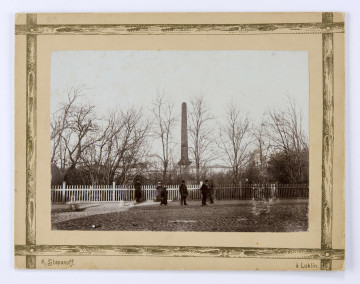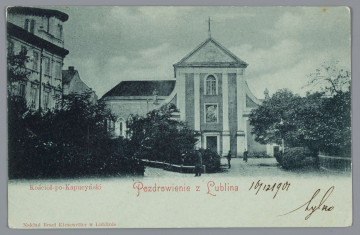
Monument to the Union of Lublin
1880 — 1900
National Museum in Lublin
Part of the collection: Lubliniana. Painting views of Lublin and the Lublin Region
View of the vast Capuchin complex as seen from today's Litewski Square. In the background one can see the Gothic post-Bridgettines church. The Capuchin Fathers, brought to Poland in 1681 by King John III Sobieski, arrived in Lublin in 1724. The founder of their Lublin foundation was the former marshal of the Grand Duchy of Lithuania, Prince Paweł Karol Sanguszko and his wife Anna Maria née Lubomirska. The Capuchins, charismatic and supportive of the poor, preachers and devoted patriots, worked in Lublin until the dissolution of the order in 1864. During the January Uprising (the monastery housed the archives of the uprising) the fathers were deported to Łomża and their land was parcelled out and sold. The Capuchins returned in 1919 and have remained here ever since. At the beginning of World War II the monks were arrested and deported to Sachsenhausen and Dachau, where they died a martyr's death. During this period, the monastery was mostly occupied by the Germans and the temple was used by the German army.
The Late Baroque monastery church of St. Apostles Peter and Paul was built between 1726-1733 according to the project of a Warsaw architect Karol Antoni Bay. Its style, similar to other Capuchin buildings, emphasizes the strict rule of the Order. Only the façade is less modest, decorated with pilasters and statues of the apostles Peter and Paul and a painting of St. Francis with Christ on the Cross (a copy from Murillo). The interior of the church is also austere, with oak, non-polychrome altars. They are decorated with few paintings, among them altar-pieces by the Dutchman Peter van Roy, portraits of the founder and King John III Sobieski hanging in the monastery choir and The Dream of Leszek the Black (from the seventeenth century) referring to the legend of the origins of Lublin, placed in the sacristy. The polyptych in the presbytery, depicting the Blessed Capuchin Martyrs of World War II, was painted in 1999 by Krzysztof Kubiak. In the crypt beneath the choir lie the remains of the founder who died in 1750 and most of his family.
Against the background of the buildings there is a monument to the Union of Lublin, commemorating the real union between the Crown of the Polish Kingdom and the Grand Duchy of Lithuania, concluded in Lublin in 1569. Cast in 1826 from iron, the obelisk is decorated with a classical relief depicting the allegory of the Polish-Lithuanian union (two women shaking hands symbolizing the Crown and Lithuania).
Renata Bartnik
Author / creator
Dimensions
cały obiekt: height: 33,9 cm, width: 26,2 cm
Object type
graphics
Technique
lithography
Material
paper
Creation time / dating
Creation / finding place
Owner
The National Museum in Lublin
Identification number
Location / status

1880 — 1900
National Museum in Lublin

1899 — 1901
National Museum in Lublin

1917
National Museum in Lublin
DISCOVER this TOPIC
Museum of King Jan III's Palace at Wilanów
DISCOVER this PATH
Educational path